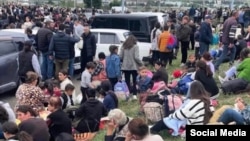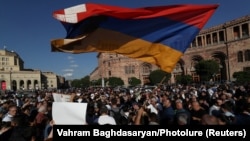As Azerbaijan moves swiftly toward retaking full control of the region of Nagorno-Karabakh, the territory’s ethnic Armenian population is facing a deeply precarious future.
The Azerbaijani government has said it has a plan to “reintegrate” the Armenians into the Azerbaijani state following its victory in a one-day offensive and the surrender of Karabakh’s de facto ethnic Armenian leadership. But Baku still hasn’t offered specifics about what reintegration might mean — and its promises to protect the rights and security of its possible new Armenian citizens have little credibility among a traumatized and frightened Karabakh population.

Representatives of the central government from Baku and Karabakh Armenians on September 21 began working out the terms of a new arrangement following the Azerbaijani offensive, which Nagorno-Karabakh authorities say has killed at least 200 people, including 10 civilians, and wounded more than 400. (RFE/RL could not independently confirm the casualty figures.) While there were no immediate results from the talks, negotiations are slated to continue.
“A whole host of questions still need to be resolved,” David Babaian, an adviser for foreign policy to the separatist government’s de facto leader Samvel Shahramanian, told Reuters following the meeting with the Azerbaijanis. “We do not know what guarantee of security our people will get. This needs to be resolved.”
WATCH: Security forces have detained more than 80 people amid anti-government protests in the Armenian capital of Yerevan.
In the immediate aftermath of the assault, uncertainty reigned in Karabakh. Many Karabakh Armenians wrote on social media that they had been separated from family members during the offensive. There were sporadic reports of continued fighting. The Russian peacekeeping contingent in the territory said it had evacuated more than 5,000 people from the regions of Martakert, Martuni, and Askeran after Azerbaijani forces advanced into those regions. As of late night on September 21, the peacekeepers said they were hosting 704 displaced people at their base at the airport in Khojaly.
Azerbaijan has said six Russian peacekeepers were killed during Baku’s military offensive. According to the country’s Prosecutor-General’s Office, five were killed “by mistake” by Azerbaijani forces and one by Karabakh Armenian fighters.
Azerbaijani forces have not yet moved into the capital of the territory, known as Stepanakert in Armenian and Xankendi in Azerbaijani. Public services and administration are, for now, still being operated by the self-proclaimed Nagorno-Karabakh Republic (NKR), which has governed the territory since the early 1990s, after Armenian separatists defeated Azerbaijan in the first war between the two sides.
A generation of ethnic Armenians in Karabakh has now grown up under the NKR’s rule, as it maintained control of the territory with Armenia’s backing. Diplomatic efforts to resolve the conflict after the first war brought little progress.
IN PHOTOS: An estimated 10,000 evacuees are seeking shelter without basic living conditions in basements, while others have massed at an airport in hopes of fleeing to Armenia.
Photo Gallery:
The two sides fought another war in 2020 that lasted six weeks before a Russian-brokered cease-fire effectively recognized the loss of Armenian control over large parts of the NKR-controlled territory. With its one-day offensive this week, Azerbaijan forced a surrender that included the full disarmament and disbandment of the NKR’s armed forces. It is not clear how much longer the NKR itself — which Azerbaijan regards as a criminal junta — will survive. Azerbaijan has promised that the Armenians of Karabakh can continue to live in the territory. But if there is any viable future for the ethnic Armenian population in Karabakh, it would represent an exception to the established pattern of zero-sum territorial control and ethnic cleansing in the Caucasus.
When Armenia won the war in the 1990s, all of the more than 600,000 ethnic Azerbaijanis who had been living in the territory that the Armenians took were forced to flee. Armenians who had been living in the territories Azerbaijan retook in 2020 were also driven out and have not been able to return. In the separatist territories of South Ossetia and Abkhazia there remain only small, beleaguered pockets of ethnic Georgian inhabitants following successive wars there; the large majority of former Georgian residents were also forced to flee.
WATCH: Thousands of ethnic Armenians gathered at Nagorno-Karabakh’s only airport seeking protection and possible transit to Armenia.
Until 2020, Azerbaijan repeatedly promised that if Armenia agreed to peacefully return the territories it had taken during the first war, then the Armenians of the region would enjoy “the highest possible autonomy” within Azerbaijan. Baku offered examples like the culturally German Tyrol district of Italy and the culturally Swedish Aland Islands in Finland. As soon as the 2020 war began, though, the promise was revoked. “We offered them autonomy…but they rejected everything,” Azerbaijani President Ilham Aliyev said during the war. Immediately after the fighting ended with Armenia’s capitulation, he then vowed: “To hell with the status, the status has gone to the grave, the status has disappeared, it is gone.”
Since that 2020 victory, Azerbaijan has refused to publicly discuss what sort of arrangements the Karabakh Armenians could receive under Azerbaijani rule. State-connected think tanks have occasionally proposed models of coexistence, but Azerbaijani officials would say only that the Karabakh Armenians would be treated as any other citizens of Azerbaijan.
Following the recent offensive and the NKR’s capitulation, some Azerbaijani officials have spoken more openly about a plan.
Hikmet Hajiyev, a senior foreign policy adviser to Aliyev, has said a plan is “ready.” Aliyev himself promised the Karabakh Armenians that “all their rights will be guaranteed: educational rights, cultural rights, religious rights, and municipal electoral rights, because Azerbaijan is a free society.”
On September 22, Hajiyev told Reuters that members of the Karabakh armed forces who lay down their weapons may be given amnesty. To many observers, though, the promises are too little and too late and to be taken at face value. Many suspect the Azerbaijani promises are simply window dressing for what would amount to another ethnic cleansing. “The Karabakh Armenians are not just any minority. They have a specific history of conflict, and they have very serious security concerns. So, I think a project to reintegrate them into Azerbaijan would require painstaking negotiations, transitional arrangements, real thinking about security guarantees, and so on,” said Laurence Broers, an associate fellow at the London-based Chatham House’s Russia and Eurasia Program, said. “What we’re seeing is that these negotiations are taking place after very severe and asymmetric episodes of violence.”
As a result, “the commitments that Azerbaijan is making are not seen as credible by the wider population in Armenia,” Broers added. “The most likely outcome that we’ll see in the coming weeks and months is a substantial outflow of people to Armenia.”
For now, while some Karabakh Armenians have gone to the airport in Stepanakert seeking protection from Russian peacekeepers and possible transit, many have said they were not allowed. Some have said it is the Russian peacekeepers who are not allowing them to leave. Armenia’s government, meanwhile, says it has made preparations for an evacuation but has not deemed such a step necessary. “We don’t want to talk about this, because we believe that the Armenians of Nagorno-Karabakh should live in their homes, in their homeland, in dignified and safe conditions,” Armenian Prime Minister Nikol Pashinian said in a video address to the nation on September 21. “At this moment, our assessment is that there is no direct threat to the civilian population of Nagorno-Karabakh.” It is not clear how many Armenians will want to leave Karabakh, either temporarily or permanently. “The overwhelming majority of the people here do not want to live as part of Azerbaijan, [and] I do not know what will happen,” Babaian said.
Given the dire humanitarian situation in Karabakh following nine months of a blockade by Azerbaijan that preceded the military offensive, many observers called for people to be allowed to evacuate.
The “next few days will be crucial in determining whether [there] will be a significant outflow of population from the region, if not complete exodus of the ethnic Armenian population,” wrote Carey Cavanaugh, a former U.S. negotiator in the Armenia-Azerbaijan talks, on X, the platform formerly known as Twitter. “Those who wish to leave Azerbaijan should be afforded that option. The international community should help facilitate their safe and secure departure from Nagorno-Karabakh and assist with their reception in Armenia.” Armenians should be allowed to at least temporarily leave Karabakh, said Philip Gamaghelyan, a longtime peace activist in the region and professor of Peace Studies at the University of San Diego. “The absolute priority is to provide the opportunity for safe passage for full evacuation of the Armenians of Nagorno-Karabakh at this stage,” he said in a September 21 online discussion. “There has been nothing done for the last three years, and especially the last nine months [of the blockade], to in some form prepare them for integration or coexistence. So, at this point, to believe that they could live safely and with some rights is very hard to imagine.” But after a “break” in Armenia, Azerbaijan should be given the chance to “prove [skeptics] wrong” and provide a suitable environment. “And then, yes, we can organize a safe return,” Gamaghelyan said.
But a temporary evacuation could turn permanent, warned Lala Darchinova, an activist and a co-editor, along with Gamaghelyan, at the Caucasus Edition journal. “As much as I don’t want to see Karabakh without Azerbaijanis, I don’t want to see Karabakh without Armenians,” she said in the same online discussion. “So, evacuation…is a very big question for me, whether people would be able to come back. But it’s a very difficult situation, because in the short term, what is the alternative for these people?”
Photo Gallery:
One factor that would likely complicate a mass exodus would be Russia. “Whether Karabakh Armenians remain or not is also unfortunately tied into geopolitical calculations around the continued Russian presence, because if there is no Armenian community remaining in Karabakh, then there is no justification for a Russian peacekeeping mission,” Chatham House’s Broers said. “It might be in Russia’s interests to see some symbolic presence there.” In a September 21 phone call with Aliyev, Russian President Vladimir Putin “emphasized the importance of ensuring the rights and security of the Armenian population of Karabakh,” the Kremlin reported. Broers said many Karabakh Armenians are unlikely to want to move to Armenia, even if their homes come under Azerbaijani control. “For many Karabakh Armenians, resettling in Armenia is not an attractive option,” he said, given Armenia’s history treating refugee Armenians as second-class citizens. “They’re really in a position of choosing between lesser evils.” The near-term future of Armenians in Karabakh is likely to be comparable to that of Serbs in Kosovo, said Shujaat Akhmadzada, a nonresident research fellow at the Baku-based Topchubashov Center, which focuses on international relations and security. That is, “there is antagonism, communities do not visit each other, they have their own symbolism in their own villages. Hopefully there is no violence, but there are occasional, let’s say antagonistic, interactions,” he said in a separate September 21 online discussion, organized by the online platform Bright Garden Voices. In the longer term, he said the situation may be comparable to that of Armenians in Turkey or Georgia.
Whatever the Azerbaijani government offers to the Karabakh Armenians it is likely to be merely for show, argued Anna Ohanian, a political science professor at Stonehill College.
“Considering that Azerbaijan is using coercive tactics, coercive strategies, the postwar conditions for Armenians who decide or are able or want to stay in Azerbaijan is not going to be pretty,” she said during the Bright Garden Voices event. “There could be some pretense for a while, in the short term, creating some sort of Potemkin villages here and there,” she said.


